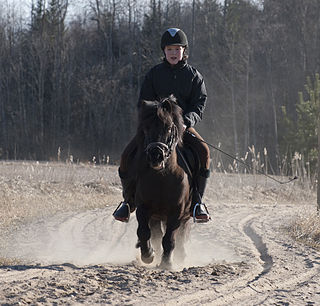
The Shetland pony is a Scottish breed of pony originating in the Shetland Isles in the north of Scotland. It may stand up to 107 cm (42 in) at the withers. It has a heavy coat and short legs, is strong for its size, and is used for riding, driving, and pack purposes.

A draft horse (US), draught horse (UK) or dray horse, less often called a carthorse, work horse or heavy horse, is a large horse bred to be a working animal doing hard tasks such as plowing and other farm labor. There are a number of breeds, with varying characteristics, but all share common traits of strength, patience, and a docile temperament which made them indispensable to generations of pre-industrial farmers.

The Percheron is a breed of draft horse that originated in the Huisne river valley in western France, part of the former Perche province, from which the breed takes its name. Usually gray or black in color, Percherons are well-muscled, and known for their intelligence and willingness to work. Although their exact origins are unknown, the ancestors of the breed were present in the valley by the 17th century. They are believed to descend from war horses. Over time, they began to be used for pulling stagecoaches; and later, for agriculture and hauling heavy goods. In the late 18th and early 19th centuries, Arabian blood was added to the breed. Exports of Percherons from France rose exponentially in the late 19th century, and the first purely Percheron stud book was created in France in 1893.
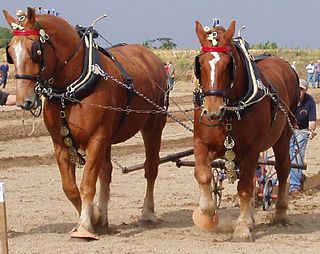
The Suffolk Horse, also historically known as the Suffolk Punch or Suffolk Sorrel, is an English breed of draught horse. The first part of the name is from the county of Suffolk in East Anglia, and the word "Punch" is an old English word for a short stout person. It is a heavy draught horse which is always chestnut in colour, traditionally spelled "chesnut". Suffolk Punches are known as good doers, and tend to have energetic gaits.

The Dole Gudbrandsdal, Dølahest, or Dole is a draft- and harness-type horse from Norway. The Dole Trotter is alternately considered a subtype of the Dole Gudbrandsdal and a separate breed; it is also considered a part of the coldblood trotter type. The Dole Gudbrandsdal is a small draft horse, known for its pulling power and agility, while the Dole Trotter is a smaller, faster horse used for harness racing; the two types are commonly interbred. Both types are strictly critiqued before entry into the studbook, which has over time resulted in an improvement in the breed type. The Dole is originally from the Gudbrandsdal Valley, and is probably descended in part from the Friesian horse. Over time, the breed has had Thoroughbred, Arabian, and other breeds added in, especially during the creation of the Dole Trotter in the 19th century. The first studbook was created in 1941, and the current breed association was formed in 1947. Although originally used mainly as a pack horse, today, the heavier Dole type is used mainly for agricultural purposes. The Dole Gudbrandsdal been crossed with other breeds to develop horses for harness racing and riding.

The Ardennais or Ardennes is one of the oldest breeds of draft horse, and originates from the Ardennes area in Belgium, Luxembourg, and France. They are heavy-boned with thick legs and are used for draft work.

The Boulonnais, also known as the "White Marble Horse", is a draft horse breed. It is known for its large but elegant appearance and is usually gray, although chestnut and black are also allowed by the French breed registry. Originally there were several sub-types, but they were crossbred until only one is seen today. The breed's origins trace to a period before the Crusades and, during the 17th century, Spanish Barb, Arabian, and Andalusian blood were added to create the modern type.
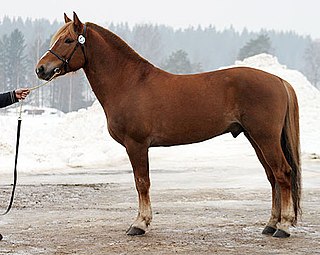
The Finnhorse or Finnish Horse is a horse breed with both riding horse and draught horse influences and characteristics, and is the only breed developed fully in Finland. In English it is sometimes called the Finnish Universal, as the Finns consider the breed capable of fulfilling all of Finland's horse needs, including agricultural and forestry work, harness racing, and riding. In 2007, the breed was declared the official national horse breed of Finland.
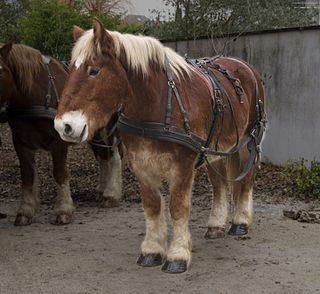
The Trait Breton is a French breed of draught horse. It originated in Brittany, in north-west France, from cross-breeding of local horses with various other breeds. It is strong and muscular, and often has a chestnut coat.

The Lithuanian Heavy Draught is a draught horse breed created in Lithuania during the 19th and 20th centuries. They are used mainly for heavy draught and farm work, as well as meat production and the improvement of other breeds. The breed is currently near extinction..

The Auxois is a horse breed from eastern France. It is a large breed, with some individuals weighing over 910 kilograms (2,010 lb), bred for horse meat, agricultural work and leisure pursuits. Overall, members of the breed are solid and muscular in appearance. They are usually bay or bay roan in color, although some other colors are accepted by the breed registry, and are known for their power and docility.

The Jutland horse is a draft horse breed originating in Denmark, named after the Jutland Peninsula which forms the western part of the country. Usually chestnut, they are a compact, muscular breed known for their calm and willing temperament. The breed was originally developed for use in agriculture, but today is more often seen in urban settings and at horse shows. Some of the best known members of the breed pull beer wagons for the Carlsberg brewery around Copenhagen, as well as at competitions and for demonstrations. Images from the 9th century show a horse similar to the Jutland being used by Viking raiders in what is now Great Britain. The first written record is from the 12th century, when they were popular as war horses. Some infusion of bloodlines from other breeds occurred in the 18th century, but the modern Jutland type only began about 1850 with the addition of blood from several other breeds, mainly draft horses. A stud book was created in the late 19th century, and the Jutland population grew to a maximum around 15,000 by 1950. Numbers subsequently declined, and as of 2011, only an estimated 1,000 horses remained.

The Trait du Nord, previously also known as Ardennais du Nord or Ardennais de type Nord, is a breed of heavy draft horse developed and bred in the area of Hainaut in western Belgium and in northeastern France. Originally considered a subtype of the Ardennes, it was recognized as an individual breed with the opening of a studbook in 1903. Developed in the fertile Flemish grasslands, it was bred for size and pulling power for agricultural work. By 1855, the horses bred near Hainaut were considered by some veterinarians to be superior to other Flemish draft breeds. The Trait du Nord was used extensively in mining from the late 19th century through 1920, with lesser use continuing through the 1960s.

The Italian Heavy Draft, or Rapid Heavy Draft, is a breed of draft horse from Italy. The full Italian name of the breed is Cavallo Agricolo Italiano da Tiro Pesante Rapido, "Italian Rapid Heavy Draft Farm Horse", and the abbreviation TPR ) is often used.
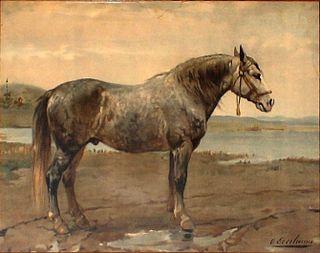
The Russian Draft or Russian Heavy Draft is a Russian breed of draft horse. It was bred in Imperial Russia in the second half of the nineteenth century, and until after the Russian Revolution was known as the Russian Ardennes. It is one of a number of draft breeds developed there at approximately the same time, others being the Lithuanian Heavy Draft, the Soviet Heavy Draft and the Vladimir Heavy Draft; it is both the oldest and the smallest of them. The present name dates from the Soviet era, and was used from 1952.

The North Swedish Horse or Swedish: Nordsvensk Brukshäst is a Swedish breed of small heavy horse. It is closely related to the similar Dølehest breed of Norway. It was traditionally used for forestry and agricultural work. Lighter lines are bred for harness racing, and are registered in the stud-book of the Svensk Kallblodstravare.
The Estonian Draft or Eston-Arden is a breed of draft horse developed in Estonia. They were developed from a cross of Estonian Native horses and Swedish Ardennes and officially recognized by the Estonian government in 1953. Population numbers have decreased since the early 1990s and today inbreeding is of significant concern and the breed is considered to be endangered by the Estonian government. Although originally used for heavy draft work, they are now used mainly for small-scale gardening.
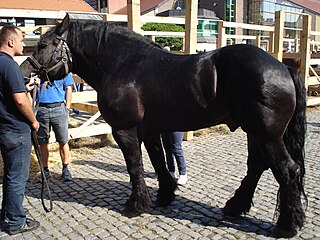
The Međimurje horse is an autochthonous medium-heavy horse breed of draught horse originating from Međimurje County in northernmost part of Croatia.

The Croatian Coldblood is an autochthonous medium-heavy horse breed of draught horse originating from Croatia.
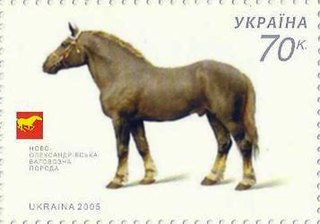
The Novoolexandrian Draught is a Ukrainian breed of draught horse. It is named for the state stud farm of Novo-Oleksandrivka in Bilovodsk Raion of Luhansk Oblast in the easternmost part of Ukraine, where it was bred. It shares its early history with the Russian Heavy Draught bred in Imperial Russia in the second half of the nineteenth century, and until after the Russian Revolution known as the Russian Ardennes; later development took place in Ukraine, where it received official recognition in 1999. It was bred for draught work, but it is also reared for meat and particularly for mare's milk, of which it is a high-yielding producer.



















